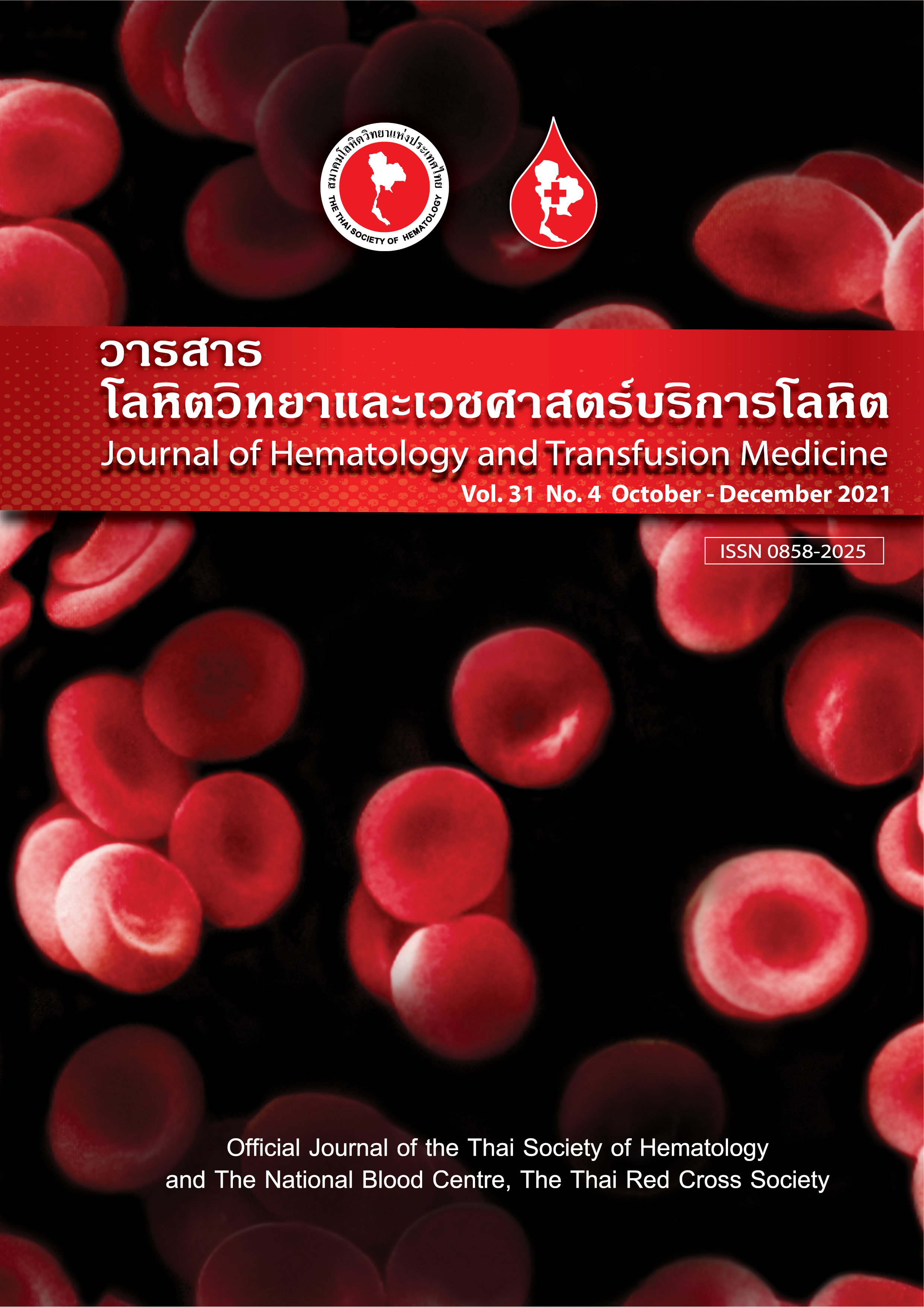ประสิทธิผลของการใช้โปรแกรมจ่ายเลือดด้วยบาร์โค้ดในหน่วยคลังเลือดและเวชศาสตร์บริการโลหิต โรงพยาบาลสงขลานครินทร์
Keywords:
Reducing errors blood issuing process, Blood issuing using software with barcodeAbstract
บทคัดย่อ
บทนำ กระบวนการจ่ายเลือดเป็นขั้นตอนหนึ่งที่มีความสำคัญที่สุดในการให้เลือดแก่ผู้ป่วย และต้องไม่ผิดพลาดเนื่องจากส่งผลโดยตรงต่อชีวิตผู้ที่รับเลือด วัตถุประสงค์ เพื่อประเมินประสิทธิผลของการใช้โปรแกรมจ่ายเลือดด้วยบาร์โค้ดเพื่อตรวจสอบความถูกต้องในการจ่ายเลือดและส่วนประกอบของเลือดที่ผู้วิจัยพัฒนาขึ้น วัสดุและวิธีการ เก็บข้อมูลจำนวนการเกิดอุบัติการณ์จ่ายเลือดผิดพลาด ย้อนหลัง 11 ปี (ตุลาคม พ.ศ. 2553-กันยายน พ.ศ. 2564) โดย 4 ปีแรก นำข้อมูลมาวิเคราะห์ปัญหา ออกแบบระบบการทำงาน พัฒนาโปรแกรมมาทดลองใช้ 2 ปี แก้ไขข้อบกพร่อง แล้วนำไปใช้จริงเป็นระยะเวลา 5 ปี เปรียบเทียบจำนวน อุบัติการณ์ที่เกิดขึ้นก่อนและหลังการนำโปรแกรมจ่ายเลือดด้วยบาร์โค้ดมาใช้ ผลการศึกษา พบว่า โรงพยาบาลสงขลานครินทร์ จ่ายเลือดให้แก่ผู้ป่วยเฉลี่ย ปีละ 83,068 ± 8,915 ยูนิต ก่อนใช้โปรแกรมจ่ายเลือดด้วยบาร์โค้ด มีผิดพลาดในการจ่ายเลือดเกิดขึ้นปีละ 2-6 ราย หลังจากใช้โปรแกรมจ่ายเลือดด้วยบาร์โค้ด มีความผิดพลาดเพียง 1 ราย และไม่มีความผิดพลาดในการจ่ายเลือดเกิดขึ้นติดต่อกันเป็นปีที่ 4 ซึ่งแสดงถึงประสิทธิผลของโปรแกรมการจ่ายเลือดด้วยบาร์โค้ดได้เป็นอย่างดี สรุป การปรับปรุงกระบวนการจ่ายเลือดโดยใช้โปรแกรมคอมพิวเตอร์ที่พัฒนาขึ้นมาตรวจสอบ ทำให้มีความถูกต้องในการจ่ายเลือด ลดความผิดพลาดจากตัวบุคคล และลดเวลาการทำงานได้เป็นอย่างดี สามารถประยุกต์ใช้ในส่วนงานอื่นๆที่เกี่ยวข้องเพื่อเพิ่มประสิทธิภาพในการทำงานต่อไป
Abstract:
Introduction: The blood issuing process is the most important part for the blood transfusion to the patients. This process must not be error because it has direct effect to the patient’s life. Objective: To evaluate the effectiveness of using the software with barcode verification developed by researcher for blood component issuing process. Materials and Methods: A retrospective analysis of 11 year data (October 2010-September 2021) were collected, four year incident reports were used to design the working procedure and develop the software with barcode verification for the blood issuing process. Trial of the software was carried out for two year in parallel with checking for software errors. The revised software was then used for five years. Finally, the numbers of incidents before and after the use of the software with barcode verification for blood issuing process were compared. Results: We found that an average of 83,068 ± 8,915 blood component units (Mean ± SD) per year were transferred to the patients in Songklanakarind Hospital. The errors on blood issuing process were 2-6 cases per year before using the software while only one case occurred after using the software with barcode. However, there was no error in issuing the blood components for over four years. These indicated the effectiveness of our software for blood issuing process with the barcode verification. Conclusion: The blood issuing process improvement by using the software with barcode verification can significantly reduce human errors and save the working time. These can apply for using in another related works to increase the efficiency in the blood transfusion medicine in the future.
Downloads
References
Chiewsilp P. Blood bank quality assurance. J Hematol Trans Med. 1998;8:105-7.
Bejrachandra S, Chongkolwatana V, Permpikul P, Siriboonrit U, Chandanayingyong D. Transfusion reported errors at Siriraj hospital. J Hematol Trans Med. 2000;10:7-15.
The Healthcare Accreditation Institute (Public Organization). Patient safety goals: SIMPLE Thailand 2018. Nonthaburi: Famous and Successful; 2018.
Jeong MG, Lee WS. A smart blood bag management system using a load-integrated U-shaped near-field RFID antenna array. IEEE Trans Antennas Propag. 2018;67:1837-43.
Pinyojit S, Khueansuwan S, Khamthita P. Development of barcode system to prevent blood component mistake. J Health Sci. 2016;25:888-96.
Ri M, Kasai M, Kohno A, Kondo M, Sawa M, Kinoshita T, et al. A survey of blood transfusion errors in Aichi Prefecture in Japan: identifying major lapses threatening the safety of transfusion recipients. Transfus Apher Sci. 2020;59:102735. doi: 10.1016/j.transci.2020.102735.
Shastry S, Sreelekshmi S, Raturi M, Baliga P. Barcode error leading to sample misidentification during blood grouping. Transfusion. 2016;56:1918-19.
Ayob Y. Getting the right unit to the right patient–how can we fix the problem. VOXS. 2016;11(S2):
-8.
Medical Technology Council. Guideline for the blood transfusion service. Bangkok: P.S. Services; 2018.
Li BN, Chao S, Dong MC. Barcode technology in blood bank information systems: upgrade and its
impact. J Med Syst. 2007;30:449-57.
Chou SS, Chen YJ, Shen YT, Yen HF, Kuo SC. Implementation and effectiveness of a bar code–based transfusion management system for transfusion safety in a tertiary hospital: retrospective quality improvement Study. JMIR Med Inform. 2019;7:e14192. doi: 10.2196/14192.
Kramkratok P, Urwijitaroon Y. Errors detected in donor blood processing for hospital blood banks at Lopburi regional blood centre: a study for quality improvement. J Hematol Trans Med. 2016;26:97-106.
Bolger G, Moss R. Reducing errors in blood transfusion with barcodes. Nurs Times. 2015;111:18-9.



